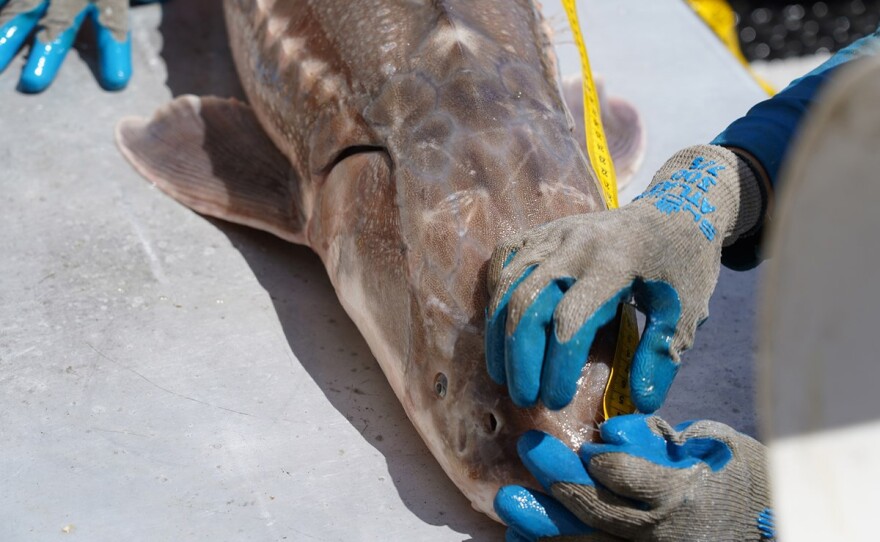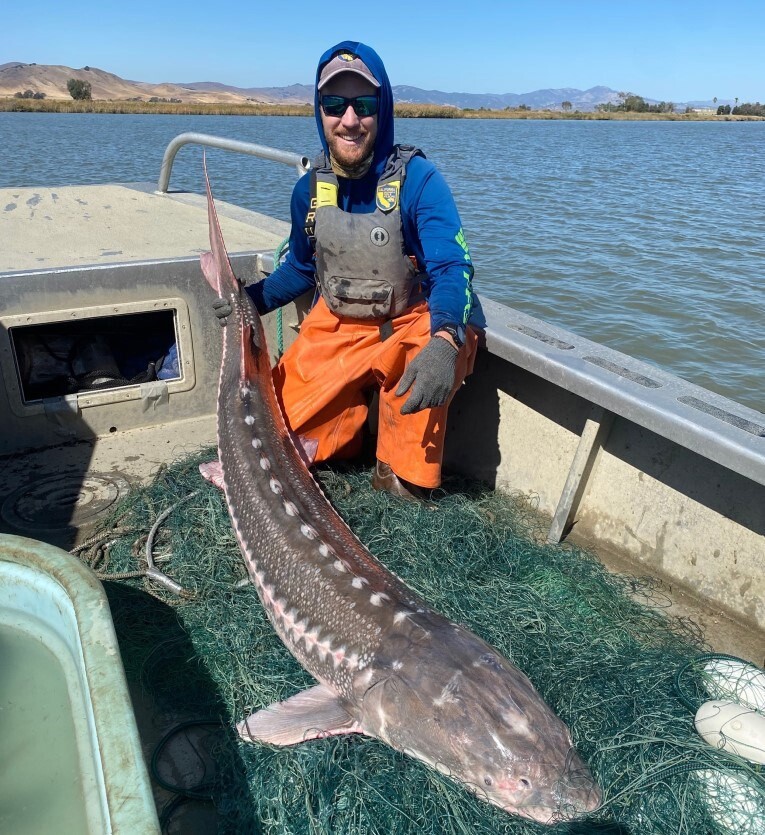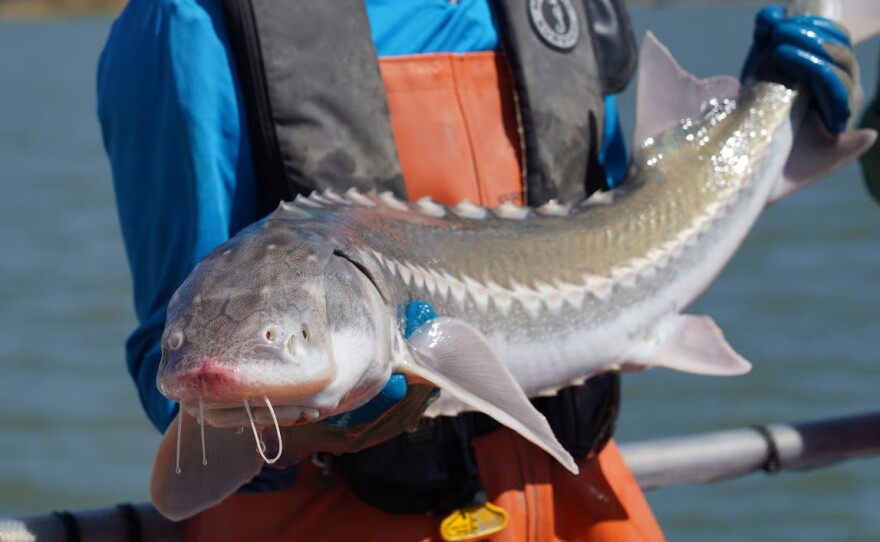The sturgeon is an ancient and iconic species of fish. Long and bony, with a body covered in armored plates known as scutes, the sturgeon has been called a “living fossil” with evolutionary roots dating back to the time of the dinosaurs.
Twenty-five different species of sturgeon exist around the world, with two — white sturgeon and green sturgeon — native to California. These fish can live for over a century, and grow to be more than 20 feet long.
Sturgeon have long been popular for sport fishing and caviar production, including in the Sacramento region. But for decades the population has been in steep decline, and that dropoff has accelerated in recent years.
A new report from the California Department of Fish and Wildlife found that the most recent white sturgeon population survey is among the lowest on record. Conducted in 2024, the survey’s numbers are only a fraction of the previous estimate less than a decade before.
John Kelly is CDFW’s Statewide Sturgeon Coordinator. He recently spoke with Insight host Vicki Gonzalez about the downward trends in white sturgeon populations, the impact on the fishing community, and why he still has hope the population can rebound.
This interview has been edited for length and clarity.
Interview highlights
When people think about California fish and conservation, salmon or delta smelt come easily to mind. But what is the environmental importance of sturgeon?
Sturgeon are this kind of iconic ancient species that have been here for a long time. If you were to go back 200 million years to the coastal waters that eventually became California, you'd find something that was recognized as a sturgeon species. If you go back about 50 million years, you'd find a white sturgeon. (For) Tyrannosaurus Rex you (only) have to go back about 60 million years. So, they've been here a long time. They're a critical part of our ecosystem.
As far as their role, they're a large benthic animal that's feeding on the bottom … interacting with all those organisms down there. They’re turning over the sediment on the bottom. And also as an anadromous fish that moves into rivers to spawn (and) spends time in saltwater, they’re helping to bring nutrients and nitrogen from the ocean into inland waters.
Are sturgeon hard to study, given their long lifespan?
Certainly. Their lifespan is basically a human lifespan. They don't become mature until they're teenagers so any management decisions we make, it can be decades before we see the actual results of that. That’s very different from an animal like a smelt or a salmon, when we’re talking about a few years.
What are the historical sturgeon habitats in California?
They can be found out in the coastal ocean, down into central California, and then up into Washington and parts of Canada. But generally, they’re found in big estuaries and rivers on the West Coast. The Sacramento (River), Central Valley rivers, and then (the) Columbia River, Snake River (and) Fraser River up in British Columbia. They would then historically have spawned several hundred miles up into those rivers, or more.
What drove sturgeon fishing early on in California’s history? Why were they popular to catch?
There was an early commercial sturgeon fishery … our first records actually date to the 1860s. Large numbers of sturgeon were captured. It wasn't a particularly high-quality food, but it was sold as a meat product and also for caviar. That (fishery) collapsed by 1901 … and it permanently closed by 1917.
It wasn’t until 1954 that we reopened it for recreational fishing only. That first fishery (was) going very intensely, and it's not a species that can necessarily tolerate that intensive level of fishing because of the long time to maturity, their long lifespan, things like that.
What has caused the decline in sturgeon populations in recent years?
There's a number of factors going on. I think the biggest is that the Central Valley and our rivers (are) a very managed system. There's a lot of demands on water. So, as we have changed and altered those flows for various reasons that has impacted fish in general, and sturgeon in particular.
Additionally there's other human impacts. There has been fishing, both legal (but) also poaching for caviar. There’s also contaminants from various chemicals that maybe may have been used, and other sources of mortality as well.
Dams that may have blocked passage to waters that used to go to in the past … also just altering the timing of when flows are high or low. We have very good evidence that sturgeon really only reproduce well in years where there’s a lot of water. Those are variable, obviously, but when we step in as humans… it also interferes with those natural life cycles.
CDFW recently did a survey to record the white sturgeon population in 2024. What did researchers find, and how did it compare to populations in previous years?
2024 was the first year that we ran (the new survey) ... we have historically targeted or paid attention to the range of about 40-to-60-inch fish because those are the (ones) people were targeting in the fishery. Now we're concerned about the overall population, so our new survey looks at the bigger group.
Confined to that 40-60 inch range so we can look back historically, our estimate was about 6,500 fish, which is low. The previous estimate that we had been using was about 30,000, and that dates from an average (between) 2016-2022. Going back further, we would have seen numbers of 150,000 or more fish in that size range.

Was that surprising to you?
It was. Now, I do want to be cautious. This is the first year of a new study, it’s a bit of a pilot … but it's lower than I probably expected. We did anticipate that there would be a decrease. There was a large harmful algal bloom that caused a big fish mortality in the San Francisco Bay in 2022. We know that impacted sturgeon as well as a lot of other species.
Most of the carcasses we were finding were large fish, breeding fish. They are the important ones currently maintaining the population. (And) any fish that were born that year, we won’t see them spawning until 15-20 years (later) for the first time. So there is definitely the immediate impact, and then we have to look forward to how that will play out over the years ahead.
Were there any silver linings in the survey numbers that give hope for the future sturgeon population?
Well the good news about sturgeon is because of that long lifespan, and because they spawn multiple times over their life unlike salmon, they’re not going to blink out. They're going to potentially die out slowly… or we can recover them slowly. We were certainly encouraged that we saw a large number of fish that were what we would consider “sub-legal fish,” (or) fish that were too small to catch. Those are the teenagers that are growing into the population… and can help rebound numbers in the future.
We also still saw some big fish, the big breeding spawners. As fish grow the bigger they are, the more eggs they produce. They're still there (so) we still have time to make changes and help these animals.
Commercial sturgeon fishing has been banned for about a century, but recreational fishing is still allowed. What are the current regulations and limitations?
There have been some recent changes. In June of last year the (white sturgeon) became a candidate species for listing under the California Endangered Species Act. That means that we have to protect them from “take,” from people potentially harming them. That closed the fishery at the time, but then we were able to propose to the Fish and Game Commission to reopen it as a catch and release fishery … that’s our current status.

It's open for the most part from Oct. 1 through the end of June. There are also some regional timing and regulations, so please check your regulation books. But it is still open … it’s a wonderful, exciting fish to catch and so hopefully people still go out.
What makes sturgeon fishing so exciting?
They’re huge. We’re talking about numbers of three feet, five feet, bigger than that. They're very powerful swimmers, so when anglers hook up on them they’ll pull the line out. They’ll jump out of the water like a marlin. It's a lot of work to land one, and so it’s kind of an exciting trophy to have under your belt.
What has been the response from anglers and the fishing community as they have had to navigate fishery closures over the past year or so?
It’s mixed. Understandably people are not not happy when we change the regulations … and restrict them from doing things. Most people fish catch and release … but they like the opportunity to keep a fish once in a while. It's nice to bring back a big trophy, some meat for the table, so there’s been some dissatisfaction from some of those anglers.
And certainly we know it’s impacted the guide and captain community. They’re trying to sell trips to clients, and clients like to bring something back with them. However, there are thriving, very lucrative catch and release fisheries in other states (along) the West Coast, so hopefully we can work with them to build that out.






